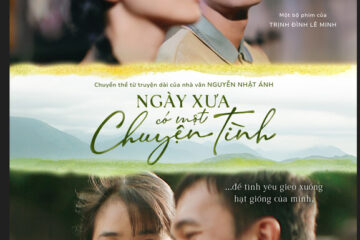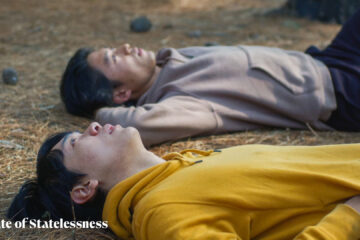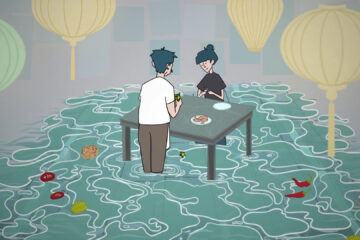In this interview, the writer and director of Summer School, 2001 (Letní škola, 2001), Dužan Duong, shares the creative vision behind his debut feature. Inspired by the visual aesthetics of Wong Kar-wai and the elliptical storytelling of Akira Kurosawa’s Rashōmon (1950), the film explores family dynamics, masculinity, and nostalgia through the eyes of three intersecting characters. Discover how working with non-actors and a unique storytelling approach helped bring this authentic tale of perspectives and cultural identity to life.
Interviewee: Dužan Duong, director and writer of Summer School, 2001 (Letní škola, 2001)
Interviewer: Jenn Thảo Nguyễn
What was your initial approach to interweaving the film’s multiple narratives? How did you go about dividing scenes and perspectives across the story?
I wanted to make a film about perspectives – how important it is to seek and investigate various angles in order to find the truth. With this in mind, I began developing Summer School, 2001. In each storyline, there are few situations that remain the same, but each character remembers them differently. That was my base.
Producers often told me I should watch Akira Kurosawa’s Rashōmon (1950). But, in the beginning, I didn’t want to be influenced by other authors. My ego wouldn’t allow me to watch it. But as time passed, and I reached the fifth year of development, I finally watched this masterpiece – and I was much closer to finishing my film.
Each character’s story is paired with a distinct visual language and soundscape. Could you share some of the inspirations or references that shaped the world of each character?
I think it’s obvious that the visuals are heavily influenced by the early works of Wong Kar-wai. Call Me by Your Name (2017) was also an inspiration for the third story, about the red-haired Kien. We have three men in the family, and each of them are different – both in personality and motivation. These aspects were a main inspiration for the different points of view in each character’s story. By making each one distinct, we could enhance the power of the film’s three chapters.
Your film explores the experience and performance of masculinity through three characters. What was one aspect of masculinity you hoped to most convey through their interactions?
When you hear the word “masculinity”, I’m sure the first things that come to your mind might be strength, bravery, or many other typical adjectives. But what I was most interested in was showing that even strong men can express their emotions and fragility. In my opinion, it is very masculine to shed a tear or admit one’s fault. Especially in Asian families in Europe, there is often no space for showing emotions or being open to communicating with each other.
Technology – whether through camera, music players, cars, or game consoles – plays a prominent role in your film. Why was it important for you to incorporate this element into your storytelling?
When I was a kid, my parents were too busy working at their stall. All I was left with was a piece of technology that kept me company. Growing up with the TV turned on all day was my childhood. It also used to educate me, and looking back at it now feels very nostalgic. I wanted to convey this nostalgia to the viewers who might still remember the year 2001.
The cast includes a wide range of actors with ties to Vietnamese Czech culture. What was your casting process like, and how did you discover the performers who ultimately became part of the film?
We knew that in Czechia there aren’t many professional actors, so we had to create our own first-time actors. We looked for them in various Vietnamese-owned businesses – nail studios, grocery stores, restaurants. Many of them got scared, but the few who were willing to try were given the chance to prove themselves. For instance, Tai (played by Tô Tiễn Tài), the youngest of the sons, is my neighbor from the local grocery store, and I’ve known him since he was about five years old.
What did you find most challenging in interpreting the Vietnamese Czech experience within a narrative framework of this nature?
The biggest challenge was how to show this story to the Czech majority, who have no clue about our traditions and complicated family dynamics. But we later found out that topics such as family relationships, communication, and masculinity are quite universal. During our screenings in the Czech Republic, I was really surprised by how well the Czech audience received our film.
In previous interviews, you have shared that you direct actors by guiding the ending of a scene rather than through scripted dialogue. How did you come to develop or prefer this approach?
I believe that if you work with non-actors, you don’t want to burden them with dialogue and text. I usually pick actors based on their real-life experience. It is the most authentic way of acting for me. When I was starting my filmmaking career, I didn’t have any fancy actors – only my friends – and this approach has somehow stuck with me to this day.
Time is a concept your narrative structure actively plays with. How do you feel time influences your approach to filmmaking?
I studied editing for one semester at the Film and TV School of the Academy of Performing Arts in Prague (FAMU), and during this time I learned to show only what is necessary for the viewers. I don’t usually waste time showing unnecessary scenes. This approach is deeply rooted in my filmmaking process. I think the ultimate goal of the editor is to guide the viewers and give them only as much information as needed for them to keep up with the story. With this mindset, I wrote a story that always returns to a few key moments. I am manipulating time to show that each character might be right and has a point.
Summer School, 2001 will be shown in-person at 3:30 PM on Saturday, October 11 at the Frida Cinema in Santa Ana. It will be preceded by the short film We’re Okay. A Q&A involving filmmakers from both films will follow the screening.


